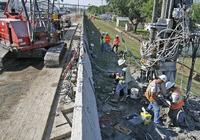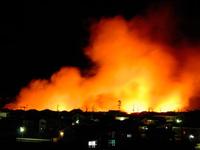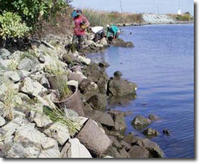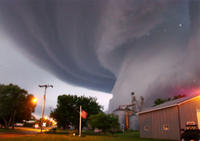-
New Jersey enacts new disaster preparedness law
On Tuesday New Jersey Governor Chris Christie signed new legislation into law designed to bolster state emergency preparedness
-
-
Fukushima decontamination efforts proves to be daunting task
For the past several months Japan has been steadily recovering from the catastrophic earthquake and tsunami that ravaged the country on 11 March, but now cleanup crews have begun to tackle one of their most difficult jobs yet – decontaminating areas hit by radioactive fallout
-
-
Fracking did not cause East Coast quake, doubts linger
Scientists have ruled out the possibility that the controversial mining technique known as hydrofracking played any part in the quake that shook the East Coast last August
-
-
Some earthquakes expected along Rio Grande Rift
The Rio Grande Rift, a thinning and stretching of Earth’s surface that extends from Colorado’s central Rocky Mountains to Mexico, is not dead but geologically alive and active
-
-
New fault lines discovered in western Washington
Geologists have discovered a series of fault lines that criss cross several mountain ranges in western Washington
-
-
New Orleans flood defense system nears completion

The Army Corps of Engineers is rapidly nearing the completion of its upgrades to the massive levee and flood defense system designed to protect the greater New Orleans area from another Hurricane Katrina
-
-
Japanese government, Tokyo Electric blasted for handling of Fukushima

A recent report revealed that Japan’s response to the nuclear crises at the Fukushima Daiichi atomic energy plant following the devastating 11 March earthquake and tsunami was riddled with false assumptions, miscommunication, and poor planning
-
-
Smartphones to save lives in natural disasters

Smartphones could help save hundreds of thousands of lives in the aftermath of a disaster or humanitarian crisis; software developed by computer scientists could help quickly and accurately to locate missing people, rapidly identify those suffering from malnutrition and effectively point people towards safe zones simply by checking their phones
-
-
Ohio injection well drilling causes tremors
The Ohio Department of Natural Resources has suspended operations at a drilling Youngstown Township fluid injection well after studies showed that the a series of tremors occurred approximately two miles below and within a mile of the injection site
-
-
Connecticut examines ways to bolster electrical grid during disasters –
Following Tropical Storm Irene and the29 October nor’easter that left thousands of homes without power across the northeast, Connecticut is considering new regulations that could bolster the power grid and improve resiliency during natural disasters
-
-
California’s flood-protection system crumbling

California has a patchwork of aging flood-protection system; it was built over the last 150 years by individuals, localities, and the state government; experts say this system, now protecting an estimated $69 billion in assets, is woefully inadequate
-
-
2011 natural disasters cost U.S. insurers more than $32 billion

2011 saw U.S. government set record for disaster declarations; the severity of the disasters set a record as well, with twelve separate billion-dollar weather/climate disasters in 2011, with an aggregate damage total of approximately $52 billion (this number reflects both insured and uninsured losses)
-
-
Buffalo – second best prepared city in U.S. for disasters
Buffalo, New York was recently declared the second best prepared city in the United States for a major terrorist attack or disaster in terms of public health
-
-
California lawmakers work to improve utilities’ disaster preparedness
California lawmakers are considering a bill to better prepare public utilities for emergencies and disasters following a series of severe storms that left thousands without power across the state
-
-
Death toll climbs in Philippines, president orders review
Following the devastating typhoon that hit the Philippines, which has resulted in the deaths of nearly 1,000 people, President Benigno Aquino III has ordered a review of the government’s disaster response
-
More headlines
The long view
The Surprising Reasons Floods and Other Disasters Are Deadlier at Night
It’s not just that it’s dark and people are asleep. Urban sprawl, confirmation bias, and other factors can play a role.
Why Flash Flood Warnings Will Continue to Go Unheeded
Experts say local education and community support are key to conveying risk.
